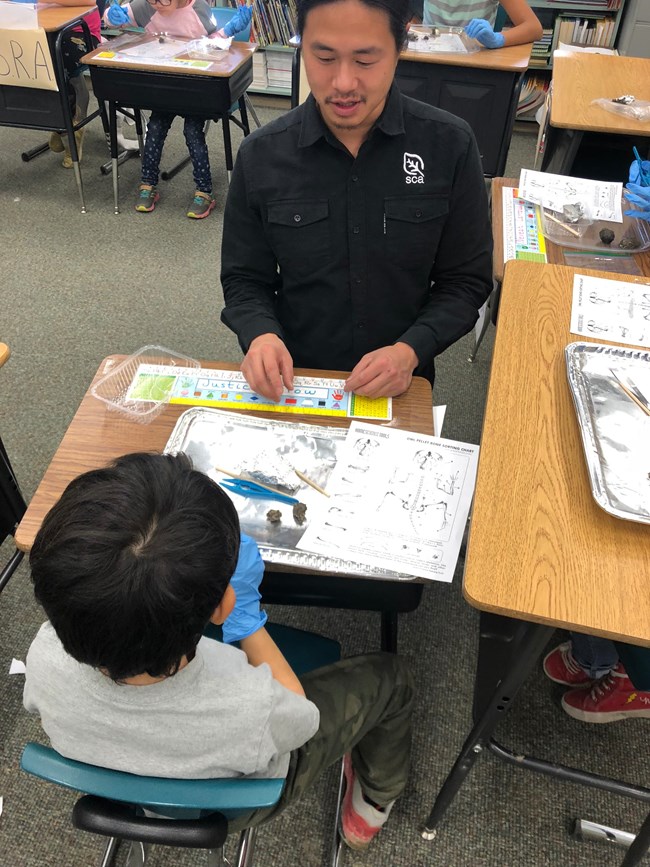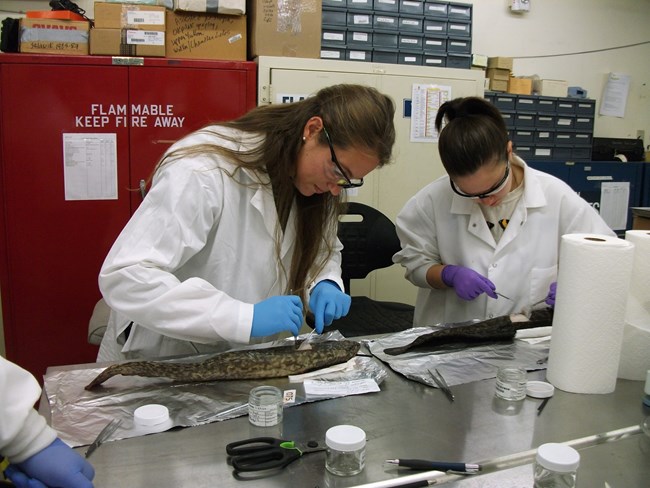Last updated: February 24, 2019
Article
2018 Science Education Grants
The Murie Science and Learning Center (MSLC) funds numerous outreach projects through the Science Education Grant program. These grants help MSLC partner parks pay for science education outreach projects. Funding for the Science Education grant program is provided by Alaska Geographic.

Science Camp at Bering Land Bridge National Preserve
Bering Land Bridge National Preserve hosted Camp Iyat (formerly known as BioBlitz) in July, 2018. Camp Iyat is a STEAM-focused multiday adventure at Serpentine Hot Springs, now in its 3rd year. Fourteen middle school students from throughout the Bering Strait region joined scientists, community volunteers, and park rangers to explore and discover incredible Arctic biodiversity. Although weather kept us in Nome this year, campers had a blast exploring the tundra ecosystem through hikes, birdwatching, insect investigation, team-building games, satellite telemetry practice, art, and more!
Connecting University Students with Nature through Science in Glacier Bay
In July 2018, scientists and educators from Glacier Bay National Park, the Arete Project and Inian Islands Institute brought twelve college students from diverse backgrounds to Taylor Bay for five days of field study. Immersed in wilderness, the students conducted biological field research including plant identification and inventory, animal sign surveys, bird identification, and small mammal trapping.The students learned how the results of scientific studies are instrumental for resource management and for connecting visitors to the park and the natural world. As apprentice field biologists learning about Glacier Bay’s rich scientific research legacy and the NPS mission, the students forged connections with the natural world, the park, wilderness, and each other.

Kobuk Valley Sand Dunes Science Camp 2018
Early in September, high school students from Noorvik and Kiana schools embarked on an exciting learning journey to the Great Kobuk Sand Dunes. Although Kobuk Valley National Park is relatively close to these villages, due to its remoteness, none of the students had visited the park. The camp introduced students to their local park resources by having them “try out” the job of field biologist.During the camp, students engaged in science based activities including minnow trapping and fly fishing, vole trapping, hiking to explore different habitats and ecosystems, a bioaccumulation game, and backcountry camping skills. The students can now say that they have slept under the Northern Lights and sunbathed on an Arctic beach. Western Arctic Parklands hopes to continue serving our communities through this camp in the coming years.

Lake Clark’s Village Day Camp Program
Since 2015 Lake Clark has delivered youth day camps in subsistence qualified partner communities. During the week-long program, National Park Service educators led games, crafts and activities for elementary age participants, and partner with a cultural demonstrator to provide culturally-relevant tradition skills activities for middle and high-school-aged participants. This project funded the development of new and innovative activities to improve the scope and quality of the day camp program.
Science Field School in Sitka National Historical Park
This summer 38 local high school and college students explored Sitka National Historical Park through the lens of research. Over eight Field School sessions, students monitored algal blooms, informed community members about the safety of shellfish harvesting, and developed a greater understanding of science careers. Sitka National Historical Park, the US Forest Service, the Sitka Sound Science Center, and the Sitka Tribe of Alaska’s Natural Resource Protection Department partnered to host this Field School.
Kotzebue Summer Science Camp and Interpretive Programs
Western Arctic National Parklands offered a beloved science camp, Camp Willow, for the 10th summer in a row! Camp Willow is for underserved Native Alaskan youth ages 10-15, and it continues to grow in popularity. During the camp, students worked alongside park rangers to learn what it takes to be a field biologist. This year, the students enjoyed learning about how researchers study voles while picking the bountiful berries on the tundra. In addition to Camp Willow, the park was able to offer more than 70 community programs this year including films, workshops, demonstrations, research presentations, and weekly kids programs. These programs cumulatively served over 1,600 participants.
Environmental Education Internship in Alaska’s Copper River Valley
The Wrangell Institute for Science and Environment welcomed Matt Roman, a student a Columbia University, as our Science and Environmental Intern. Matt worked on planning, logistics, and implementation for 8 day hikes, two science camps, a summer-long outdoor leadership course for teens, and many other programs. The intern serves as a mentor and role model for youth, giving them a glimpse of possible paths for their future. Our intern came straight from New York City, so the chance to share Alaska’s public lands and see them through his eyes was a lesson in appreciation. An avid photographer, the intern captured many great moments through the summer, and worked on outreach through our website and social media.
Science Camps in Wrangell-St. Elias National Park
In the Copper River Valley, Wrangell Institute for Science and Environment guided local youth towards stewardship ethics and careers in science with two science camps, Aquatic Ecology and Geology. During the Geology program ten teens backpacked near the Root Glacier in McCarthy, experiencing the thrill of hearing it grind and learning about the dynamic forces which have shaped the landscape. During the Aquatic Ecology program, ten youth spend three days exploring the aquatic world at Silver Lake, learning about macroinvertebrates, canoe safety, and getting an evening visit from a local beaver. Grant funds allowed us to develop comprehensive lessons and work plans, making them easier to use and share with other educators statewide.
Writing-in-the-Woods Camp in Fairbanks
Writing in the Woods is a week-long, nature journaling day camp for urban, elementary-aged students from the Fairbanks metropolitan area. The program fosters connections between youth and the natural world, cultivates science literacy, and reinforces academic skills and knowledge through nature journaling. During field trips to nearby natural areas, participants explored a variety of interior Alaska ecosystems and plant community types with National Park Service and partner educators. Activities included hikes, scientific inquiry activities, group and individual journaling sessions, instruction in Leave No Trace ethics and outdoor safety, nature-based games, and unstructured exploration. After the program, campers shared their experiences with their families, community members, and out-of-state visitors by displaying their work at the Morris Thompson Cultural Center.
Falcons and Friendship Continued – Outreach in Circle and Central
This summer National Park Service (NPS) staff were joined by partners from Alaska Pacific University and Student Conservation Association to provide information to students about education and career opportunities in Circle, Alaska. Since 1975, Circle has been the launch site for Yukon-Charley Rivers National Preserve’s annual long-term American Peregrine Falcon surveys and many other NPS studies, including shallow lakes monitoring, archaeology, moose, wolf and botanical surveys. During the three-day event, we shared the results of our research, promoted a better understanding of the NPS mission, and provided information about possible career or volunteer opportunities for youth within NPS and partner organizations. Through providing educational outreach activities in the school, sharing a meal together at the community dinner, and enjoying outreach activities, we continued to build upon the rapport and friendships that we have developed through time with Circle and Central residents.
Engaging Students in Laboratory Research and Science Communication
This summer, interns took to the lab to tackle big questions about environmental contaminants. Mentored by experts from U.S. Fish and Wildlife Service Environmental Contaminants Program and the National Park Service, the students prepared small mammal samples for contaminant analysis using tissue samples from Denali National Park, Kobuk Valley National Park, and Gates of the Arctic National Park and Preserve. There is a proposal to build an industrial road through Gates to access the Ambler Mining District, so the students’ results will facilitate comparisons of baseline contaminants levels between Denali, Gates, and Kobuk prior to road construction. The students also prepared samples from bird eggs, fish, and moose. The students presented their results at the Alaska Forum on the Environment and Alaska Bird Conference, and earned an Environmental Studies credit through UA Bristol Bay.
Caribou Hunter Education Program
In 2018, Maniilaq Association hired an intern to work with the National Park Service in Kotzebue, Alaska to help increase communication with hunters about caribou hunting traditions and regulations. The Western Arctic Caribou Herd Intern, Kayla Booth, created a logo, worked on an educational short film, and participated in village meetings and field work.In her words: “I was excited to learn new things every day. I got to participate and help set up meetings with the National Park Service, Fish & Wildlife along with Fish & Game which was an exciting and accomplishing feeling in the end. I got to travel to surrounding villages for Hunter Success meetings and discuss hunting regulations. I not only attended these meetings, but I have learned a lot and it was interesting to see how each department holds value and meaning and truly makes an impact in this region.”

Power of Place Educator Workshop at Bering Land Bridge National Preserve
Bering Land Bridge National Preserve hosted its first Educator Workshop at Serpentine Hot Springs in August of 2018. The Power of Place Educator Workshop brought together three teachers and three park educators along with talented facilitators from the Bureau of Land Management’s Campbell Creek Science Center, the Iditarod Historic Trail Alliance, the State Historic Preservation Office, and the Arctic Inventory & Monitoring Network. During the five-day workshop, fueled by fresh-picked blueberries from Serpentine Hot Springs valley, we engaged in sharing and learning strategies to incorporate place-based service learning in the classroom and beyond. It was a wonderfully successful pilot program!Tags
- alaska public lands
- bering land bridge national preserve
- cape krusenstern national monument
- denali national park & preserve
- gates of the arctic national park & preserve
- glacier bay national park & preserve
- kobuk valley national park
- lake clark national park & preserve
- noatak national preserve
- sitka national historical park
- wrangell - st elias national park & preserve
- yukon - charley rivers national preserve
- research learning center
- research learning centers
- science education
- microgrant
- microgrants
